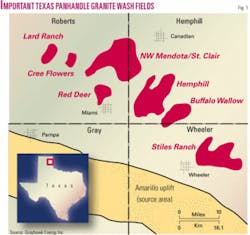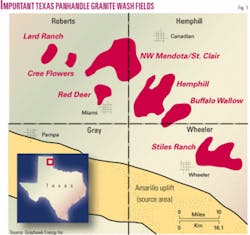Laterals tap Texas Panhandle Granite Wash gas
Horizontal drilling and slick water frac jobs have come together to fuel a new area of activity in the Pennsylvanian Granite Wash play in the northeastern Texas Panhandle.
Although more than 600 wells have been drilled in this play in the past 5 years, only two operators have tried horizontal drilling. The first of those is Grayhawk Operating Inc., a private Plano, Tex., independent.
Grayhawk Operating has found Lard Ranch field ideal for horizontal drilling because the Granite Wash has 40-45 ft of net pay centered on 80 ft of gross pay at an average depth of 8,600 ft with no water-bearing formations above or below the pay. The company drills a lateral centered in the pay and performs three to four large slick water fracs through cemented casing.
The company believes each horizontal well will tap more than 3 bcf, about three times that of a vertical well, at $2.3-2.5 million or twice the cost of a vertical well.
In addition to increased production rates and reserves compared with vertical wells, the development of Lard Ranch field with horizontal wells will enable Grayhawk Operating to produce the hydrocarbons from a given section of land with less than half the number of wells compared with a vertical well development plan. This decreases the surface impact and has been well received by landowners.
Since the Granite Wash at Lard Ranch field produces small volumes of water, water disposal wells and related infrastructure are not needed. The field is in Roberts County 20-25 miles northwest of Miami in the Anadarko basin.
Horizontal drilling results
Grayhawk Operating’s first horizontal Granite Wash well, Lard Ranch 1-60, has yielded 439 MMcf of gas, 9,900 bbl of light oil, and 2,625 bbl of water in its first 11 months on line.
Still making nearly 1 MMcfd of gas, 20 b/d of oil, and 4 b/d of water, it paid out in 10 months. The gas is 1,300 Btu/Mcf, and the oil is near 50° gravity.
Convinced of the economic merits of horizontal drilling, Grayhawk Operating in February extended the field’s productive limits with completion of the Kivlehen 1-5 and Tolbert-Kivlehen 1-62. Each is producing 2 MMcfd, 30 b/d of oil, and 20 b/d of water with more than 1,500 psi flowing tubing pressure after being on line for 60 days. CAOF exceeded 15 MMcfd at both wells.
Grayhawk Operating expects to increase the production rates on these new wells following a recent expansion of gas gathering capacity in the field.
“The company is completing three other horizontal Granite Wash wells at Lard Ranch and will have six horizontal wells and one vertical well producing by the end of April 2006,” said Cory Richards, president.
Lard Ranch field
The field, discovered in 1958, had a few wells making less than 200 Mcfd combined until last year, Richards said.
The field’s productive limits extend well beyond the area currently producing, but the reservoirs are low permeability and were not economic to develop until new technologies and improved product prices arrived.
Lately, Chesapeake Energy Corp., J-Brex Exploration, Grayhawk Operating, and Tulsa independents Latigo Oil & Gas Co. and Prospective Investment & Trading Co. have been running two to four rigs at a time and hiked field production to more than 15 MMcfd.
Although its largest acreage block is centered in the Lard Ranch field area, Grayhawk Operating has more than 18,000 gross and 12,500 net acres under lease in Roberts and Hemphill counties at 70-100% interest and operates the wells it drills. Besides Granite Wash, the acreage has prospects in the Brown dolomite, Des Moines, Morrow, and Hunton formations.
Granite Wash Trend
With cumulative production exceeding 1 tcf of gas equivalent, the Granite Wash formation is a logical target for new drilling and completion technologies.
Operators have been using slick water fracs similar to those used in the North Texas Barnett shale play in vertical Texas Panhandle Granite Wash wells for 3-4 years.
Larger Granite Wash fields east of Lard Ranch, such as Hemphill, Buffalo Wallow, and Stiles Ranch aren’t as likely to utilize horizontal drilling. This is because most are several thousand feet deeper, have larger volumes of producible water, and have several stacked packages of Granite Wash sands that make it difficult to determine which interval is the best target for a lateral.
Nevertheless, operators will watch a recent horizontal Granite Wash well that Newfield Exploration Co., Houston, drilled in Hemphill field with initial flow of more than 2 MMcfd in a square mile occupied by 16 vertical Granite Wash gas producing wells.
This indicates that even in the stacked-pay fields, some zones that were either not completed because they were lower porosity or were not effectively completed may be candidates for future horizontal drilling, Richards said.

